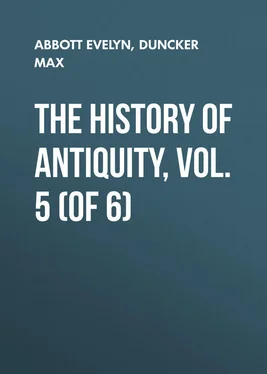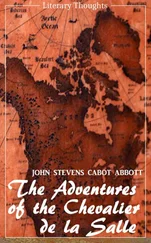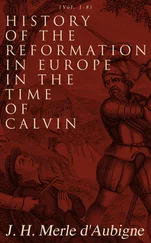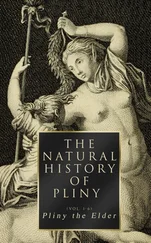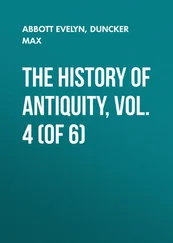Evelyn Abbott - The History of Antiquity, Vol. 5 (of 6)
Здесь есть возможность читать онлайн «Evelyn Abbott - The History of Antiquity, Vol. 5 (of 6)» — ознакомительный отрывок электронной книги совершенно бесплатно, а после прочтения отрывка купить полную версию. В некоторых случаях можно слушать аудио, скачать через торрент в формате fb2 и присутствует краткое содержание. Жанр: foreign_antique, foreign_prose, Историческая проза, на английском языке. Описание произведения, (предисловие) а так же отзывы посетителей доступны на портале библиотеки ЛибКат.
- Название:The History of Antiquity, Vol. 5 (of 6)
- Автор:
- Жанр:
- Год:неизвестен
- ISBN:нет данных
- Рейтинг книги:4 / 5. Голосов: 1
-
Избранное:Добавить в избранное
- Отзывы:
-
Ваша оценка:
- 80
- 1
- 2
- 3
- 4
- 5
The History of Antiquity, Vol. 5 (of 6): краткое содержание, описание и аннотация
Предлагаем к чтению аннотацию, описание, краткое содержание или предисловие (зависит от того, что написал сам автор книги «The History of Antiquity, Vol. 5 (of 6)»). Если вы не нашли необходимую информацию о книге — напишите в комментариях, мы постараемся отыскать её.
The History of Antiquity, Vol. 5 (of 6) — читать онлайн ознакомительный отрывок
Ниже представлен текст книги, разбитый по страницам. Система сохранения места последней прочитанной страницы, позволяет с удобством читать онлайн бесплатно книгу «The History of Antiquity, Vol. 5 (of 6)», без необходимости каждый раз заново искать на чём Вы остановились. Поставьте закладку, и сможете в любой момент перейти на страницу, на которой закончили чтение.
Интервал:
Закладка:
6 6 Arrian, "Anab." 3, 27; Diod. 17, 81; Strabo, p. 724.The ruins of cities and works of irrigation testify to the former prosperity of this region. East of the Zarakas, up the valley of the Arghandab, dwelt the Arachoti. In the inscriptions of the Achæmenids they are called Harauvati ; in the Avesta, Harahvaiti , i. e. the rich in water. These names the Arachoti received from the river on which they were settled, the older name of which was Arachotus ( Sarasvati ).
7 7 Vol. IV. p. 33.Herodotus does not designate the Arachoti by this name derived from the river of their land, but by the tribal name of Pactyes; he tells us that they wore peculiar bows, daggers, and skins.
8 8 The city of Kapisakani, which Darius, according to the inscription of Behistun (3, 9, 1), conquered in the land of the Arachoti, is no doubt the Capissa of Pliny, in the district of Capissene; "Hist. Nat." 6, 25. Pliny speaks of the city and river of Cabul as belonging to the Arachoti. The inhabitants of the southern slope of the Hindu Kush are known to the Greeks as Paropanisadæ. The explanation of the name by Paropanisos (Paropamisus), Paropanishadha, given by Lassen, is quoted in Vol. IV. p. 21, n. 2. In the Babylonian text of the inscription of Behistun, the Gandaras of the Persian text are called Parupanisana. In the narrower sense the name denotes the south-western part of the range of the Hindu Kush, the group which forms the cradle of the Herirud and Hilmend, the modern Ghuristan, to the west of the plateau of Ghasna.The Afghans, who in ancient times occupied the region from the Suleiman mountains on the east as far as the Arghandab on the west, Shorawak on the south, the Cabul and the range of the Sefid-Kuh on the north, and in the middle ages forced their way to Cabul and Peshawur, still call themselves Pashtun and Pakhtun, or Rohilo, i. e. mountaineers. They still speak their old rough mountain language, which is closely connected with the dialects of the Arian tribes on the Indus.
9 9 Lassen, "Indische Alterthumskunde," 1, 428. Fr. Müller ("Ueber die Sprache der Afghanen") is of the opinion that the Afghan does not come between Indian and Persian, but belongs to the Iranian stem, and the Afghan has preserved the old Bactrian relations of sound more faithfully than the Persian, and thus shows itself to be a direct descendant of the old eastern dialect of Iran. Trump proves that Afghan is an ancient independent language of strong Indian type. "Z. D. M. G." 21, 10 ff.
Eastward of Elburz, the point where the northern edge of Iran again rises into a lofty range to the west (Demavend is more than 18,000 feet in height), and then sinks down to the Caspian Sea, lay the Hyrcanians. In the inscriptions of the Achæmenids their land is known as Varkana ; the modern name is Jorjan. Here, according to the Greeks, the mountains were covered with forests of oaks, where swarms of wild bees had their hives; in the valleys vines and fig-trees flourished, and the soil down to the sea was so luxuriant that corn grew from the fallen grains without any special sowing. 10 10 Strabo, pp. 508, 514, 724; Plin. "Hist. Nat." 6, 29; Diod. 17, 75.
The description is hardly exaggerated. The waters pouring from the heights and snow-fields of Elburz water the soil of the coast so thoroughly, that a tropical growth flourishes in Jorjan, Taberistan, and Ghilan, the luxuriance of which is assisted by the volcanic heat of the earth. The lagunes of the coast are succeeded by marsh forests; higher up are fields of rice and plantations of sugarcane, and beyond these fertile meadows, above which splendid forests of oaks, planes, and elms clothe the heights of Elburz. There is abundance of water fruits, figs and mulberries, olives and oranges, and the vigorous creepers of the vines run even to the summits of the trees. 11 11 Ritter, "Erdkunde," 8, 425 ff.
Nevertheless, these favoured regions have a darker side. Frequent earthquakes disturb the soil; in the winter furious north winds blowing over the Caspian rage along the walls of Elburz, and even on the outlying spurs the snow falls to the depth of several fathoms; the rain-clouds, hemmed in by the mountain ranges, often burst in water-spouts, which lay the land far and wide under water, and roll as torrents down the gorges; the marsh air blanches the inhabitants, while in the summer the hot and moist climate breeds deadly fever.
Further to the east, where the Caspian Sea ends and the mountains of Iran descend towards the desolate, pathless steppes of the Oxus, is a wild, hilly country. In the depressions, and there only, the region of the Parthians ( Parthava in the inscriptions of the Achæmenids 12 12 Isid. "Charac. Mans. Parth." 10-14. The Parthians rose with the Hyrcanians against Darius; Parthians and Hyrcanians formed one satrapy. The Parthians are the Pahlav of Moses of Khorene, the Pehlew of later writers. The mention of them in the inscriptions of Darius proves that they are not a later immigrant Scythian, i. e. non-Arian, nation, as Justin, Strabo, and others maintain. The cities which the inscription of Behistun mentions in Parthia (2, 95; 3, 4), Viçpauzatis and Patigrabana, we cannot fix more definitely; Ammian (23, 6) mentions Patigran in Media. Parthunisa, with the graves of the Parthian kings, mentioned in Isidorus, "which the Greeks call Nisæa," is Parthava-Niçaya, and must be sought for near the modern Nishapur. It must be the Niça which the Vendidad places between Mouru and Bakhdhi. Justi, "Beitrage," 2, 6 compares Isidorus' Βατζιγράβαν, ὅ ἐστι τελώνιον.
) exhibits fruitful lands, and, further eastward still, agriculture is favoured by the long, narrow valley of the Areios (Herirud). Springing from the southern slope of the Hindu Kush, the river flows towards the west along the inner edge of the table-land, till it bursts through the northern barrier in order to lose itself in the sand of the steppes. In this valley the district of the modern Herat, lay the Areians, who are called Haraiva in the inscriptions of the Persian kings. The name points to the possession of water. To the north of the Areians, in the valley of the Margos (now Murghab), which rises in the northern edge of the table-land, and flows to the north-west, where it also ends in the sands of the desert, in Margiana (Old Persian, Marghush; Bactrian, Mouru; modern Merv), lay the Margiani, in a well-cultivated region, rich in vineyards, with numerous cities and a large population. But the fertility only extends so far as the soil can be watered from the Margos and the neighbouring streams.
Интервал:
Закладка:
Похожие книги на «The History of Antiquity, Vol. 5 (of 6)»
Представляем Вашему вниманию похожие книги на «The History of Antiquity, Vol. 5 (of 6)» списком для выбора. Мы отобрали схожую по названию и смыслу литературу в надежде предоставить читателям больше вариантов отыскать новые, интересные, ещё непрочитанные произведения.
Обсуждение, отзывы о книге «The History of Antiquity, Vol. 5 (of 6)» и просто собственные мнения читателей. Оставьте ваши комментарии, напишите, что Вы думаете о произведении, его смысле или главных героях. Укажите что конкретно понравилось, а что нет, и почему Вы так считаете.
